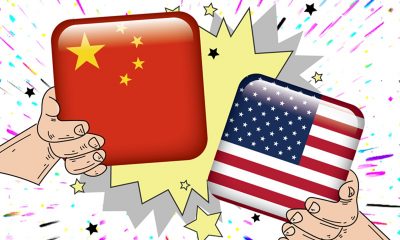US Digital War Against China: A Means to Preserve World Domination?

All Global Research articles can be read in 51 languages by activating the “Translate Website” drop down menu on the top banner of our home page (Desktop version).
Visit and follow us on Instagram at @crg_globalresearch.
***
Alongside its trade war, the US government is also engaged in a digital war against China. A central target of this US war is microchips, the heart of all information technology devices and development.
In September 2020, the US imposed a draconian ban on export of crucial materials needed by China’s leading chip manufacturer Semiconductor Manufacturing International Company (SMIC). The ban was instigated at the behest of the US Department of Defense on the alleged grounds that Chinese chips posed a threat to the US. This move also came in the wake of an earlier ban on export of chips for use by leading Chinese telecommunication company Huawei.
On June 3, US President Joe Biden issued a revised and expanded list that forbids owning or trading any stocks or securities related to 59 Chinese companies, on the supposed ground of threat from “Chinese surveillance technology.” Major Chinese companies listed include SMIC, China Mobile, China Unicom, China National Offshore Oil Corp, Hangzhou Hikvision Digital Technology Co and Huawei.
On June 8, the US Senate passed a legislation containing a whole range of anti-China provisions, including a $52 billion “Chips for America Fund” intended to deprive China of access to high-end chips by subsidizing manufactures who locate either factories in the US. This legislation is expected to go to the US House of Representatives and become law. Grounds for this legislation also include claims that microchips in Chinese hands somehow constitute a security threat to the US.
Finally on June 9, Biden issued an order for foreign-based apps to be examined for “unacceptable national security risks they pose to US interests.” The Executive Order on Protecting American Sensitive Data from Foreign Adversaries explicitly points to Chinese apps as among ones that are antithetic to the national security, foreign policy and economy of the US.
The US seeks to justify its digital war with spurious, unsubstantiated claims that Chinese companies and technologies constitute a military or “security threat” to the US. The real objective, however, is to halt Chinese development of high-tech industries that the US regards as threatening its drive to exert economic and military dominance in Asia and around the world.
To understand just why Chinese high-tech is deemed a threat to US dominance, we need to look at the current path of technology development. Social, economic, political, military, educational, scientific, and personal life already increasingly rely on the internet. With the advent of the internet of things (IoT), the internet will rapidly become the fundamental infrastructure for all human life on earth.
It’s crucial to understand that – important as human-to-human interaction is – the internet is no longer primarily about human communication and information sharing. The internet is jumping down from our computer and phone screens into the entire world around us including the bodies, minds, and selves of human beings.
The IoT includes billions of networked entities of all kinds. Each of these entities interacts simultaneously with the real world around it and with one another via the online world. These networked entities typically include sensors to monitor the world around them, which allows them to act based on their information.
The IoT currently includes six million connected human beings and 50 billion other entities, which is projected to climb in the next few years to 500 billion. As artificial intelligence (AI) and robotics merge with the IOT, the world will soon consist of innumerable connected entities and increasing numbers of intelligent connected entities.
IoTs do not stand alone. They talk to one another online generally with little or no human intervention. They can be of almost any type, including bridges, buildings, cities, human bodies, cows, refrigerators and cars; government functions and military aircraft and missiles; factory machines, logistics and product distribution; science labs and education.
IoT technology is currently converging with artificial intelligence (AI), big data and robotics. IoT entities are typically equipped with a “controller,” which includes a set of sensors to monitor their immediate environment and an actuator, which can initiate action based on input from the sensors and online input and interactions with other online entities
These entities frequently generate “big data” – huge amounts of data – which human beings alone cannot effectively interpret. AI is then needed to manage and make decisions based on the big data. Robotics, previously a separate discipline, is also converging with the IoT as connected robots.
In the face of these world-changing developments, the US and China have opposite approaches.
The US’ approach is to exercise control of digital technology to ensure that it can be used to maintain its dominance of the planet. That approach is telegraphed in the phrase now used by Biden and other US politicians that “the US must win the 21st century.” The idea that one country must win – i.e. own – a century is disturbing to say the least.
China’s approach, on the other hand, is quite different. It is to develop and share the technology for the benefit of the Chinese people and to share it with the world for “building a community with a shared future for mankind.”
*
Note to readers: Please click the share buttons above or below. Follow us on Instagram, @crg_globalresearch. Forward this article to your email lists. Crosspost on your blog site, internet forums. etc.
This article was originally published on Global Times.
Eric Sommer is a Canadian scholar and a frequent contributor to Global Research.
Featured image is from Global Times

